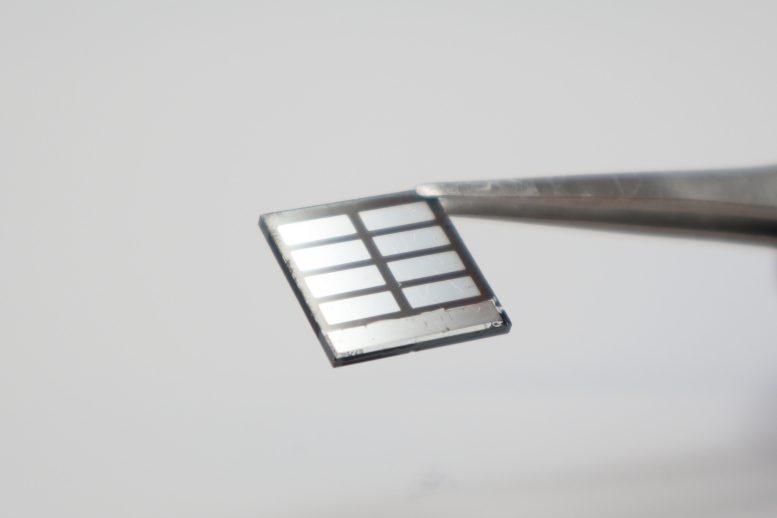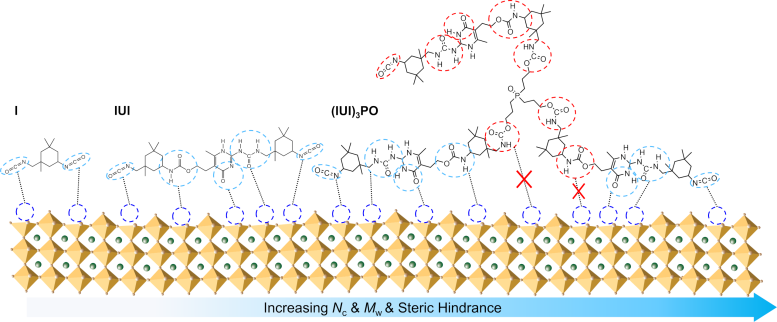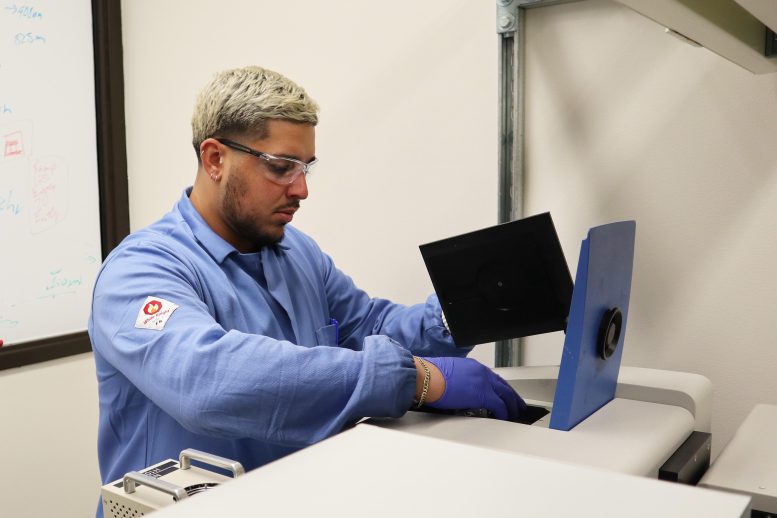
Perovskite solar cells like this one, made by Xiwen Gong’s group, could make solar energy cheaper and more environmentally friendly—but they degrade faster than silicon. In a study published in the journal Matter, the team discovered how to make the black perovskite film last longer. Credit: Zhengtao Hu, Gong Lab, University of Michigan.
The findings may enable engineers to systematically identify the most effective molecules for extending the lifespan of perovskite solar cells, moving away from a reliance on time-consuming trial-and-error methods.
A discovery at the University of Michigan provides key insights into preventing rapid degradation of perovskite
“Silicon solar cells are great because they are very efficient and can last for a very long time, but the high efficiency comes with a high cost,” said Xiwen Gong, U-M assistant professor of chemical engineering. “To make high-purity silicon, temperatures over 1,000 degrees 
Xiwen Gong’s team designed these three molecular additives to study how an additive’s size and configuration impact the stability of perovskite films, a class of materials that could be used to make high-efficiency, low-cost solar cells. The additives can prevent defects—which hurt the efficiency of the solar cells—from growing at breaks perovskite crystal lattice, known as grain boundaries. The perovskite lattice is shown as an array of yellow diamonds while the defect sites are shown as dark blue dashed circles. The dashed black lines depict bonds that can potentially form between perovskite and additives. The bulkiest molecule covers the most defects at the surface of the perovskite grains while also increasing the overall size of the grains during the manufacturing process. Larger perovskite grains result in a lower density of grain boundaries throughout the film, which reduces the number of locations where defects can form. Credit: Carlos A. Figueroa Morales, Gong Lab, University of Michigan.
Understanding Perovskite Defects
Perovskite crystals contain lead atoms that aren’t fully bound to the other components within the perovskite. Such “undercoordinated sites” are defects often found on the crystal surfaces and at grain boundaries where there’s a break in the crystal lattice. These defects hinder the movement of electrons and speed up the decay of the perovskite material.
Engineers already know that mixing defect pacifying molecules into the perovskites can help lock up the undercoordinated lead, in turn preventing other imperfections from forming at high temperatures. But until now, engineers didn’t know exactly how a given molecule affected the hardiness of perovskite cells.
“We wanted to figure out what features on the molecules specifically improve the perovskite’s stability,” said Hongki Kim, a former postdoctoral researcher in chemical engineering and one of the study’s first authors.
Research on Perovskite Additives
To investigate the problem, Gong’s team created three additives with a range of shapes and sizes and added them into thin films of perovskite crystals, which can absorb light and convert it to electricity. Each additive contained the same or similar chemical building blocks, which made size, weight and arrangement the main properties differentiating them.

Doctoral student Carlos Alejandro Figueroa Morales places a perovskite thin film sample into a spectrometer that measures the light-emitting properties of the perovskites. Changes in how the perovskite films emit light when made with the different additive molecules can reveal how many defects are inside the perovskite. Credit: Zhengtao Hu, Gong Lab, University of Michigan.
Then, the team measured how strongly the different additives interacted with perovskites and consequently influenced the formation of defects in the films. Larger molecules by mass were better at sticking to the perovskite because they had more binding sites that interact with perovskite crystals. As a result, they tended to be better at preventing defects from forming.
But the best additives also needed to take up a lot of space. Large but skinny molecules resulted in smaller perovskite grains during the manufacturing process. Smaller grains aren’t ideal because they also create perovskite cells with more grain boundaries, or more areas for defects to form. In contrast, bulky molecules forced larger perovskite grains to form, which in turn reduced the density of grain boundaries in the film.
Influence of Additive Size and Shape
Heating the perovskite films to over 200 degrees Celsius confirmed that bulky additives helped the films retain more of their characteristic slate black color and develop fewer structural defects.
“Both the size and configuration are important when designing additives, and we believe this design philosophy could be implemented across various perovskite formulations to further improve the lifetime of perovskite solar cells, light emitting devices and photodetectors,” said Carlos Alejandro Figueroa Morales, a doctoral student in macromolecular science and engineering and one of the study’s first authors.
Reference: “Molecular design of defect passivators for thermally stable metal-halide perovskite films” by Hongki Kim, Carlos A. Figueroa Morales, Sijun Seong, Zhengtao Hu, Nancy Muyanja, Saivineeth Penukula, Tony Zheng, Zachary Pizzo, Carissa S. Yim, Andrej Lenert, Nicholas Rolston and Xiwen Gong, 9 January 2024, Matter.DOI: 10.1016/j.matt.2023.12.003
Xiwen Gong is also an assistant professor of electrical and computer engineering, materials science and engineering, macromolecular science and engineering, and applied physics. The research was funded by the University of Michigan and relied on a scanning electron microscope funded by the National Science Foundation. Co-author Nancy Muyanja led the microscopy measurements at the Michigan Center for Materials Characterization.


